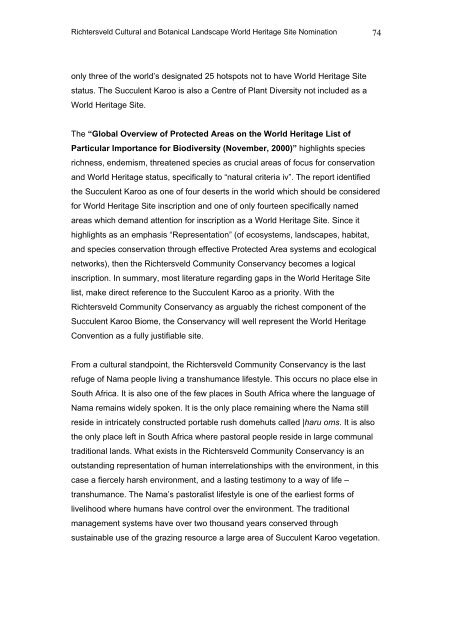the richtersveld cultural and botanical landscape - SAHRA
the richtersveld cultural and botanical landscape - SAHRA
the richtersveld cultural and botanical landscape - SAHRA
Create successful ePaper yourself
Turn your PDF publications into a flip-book with our unique Google optimized e-Paper software.
Richtersveld Cultural <strong>and</strong> Botanical L<strong>and</strong>scape World Heritage Site Nomination 74<br />
only three of <strong>the</strong> world’s designated 25 hotspots not to have World Heritage Site<br />
status. The Succulent Karoo is also a Centre of Plant Diversity not included as a<br />
World Heritage Site.<br />
The “Global Overview of Protected Areas on <strong>the</strong> World Heritage List of<br />
Particular Importance for Biodiversity (November, 2000)” highlights species<br />
richness, endemism, threatened species as crucial areas of focus for conservation<br />
<strong>and</strong> World Heritage status, specifically to “natural criteria iv”. The report identified<br />
<strong>the</strong> Succulent Karoo as one of four deserts in <strong>the</strong> world which should be considered<br />
for World Heritage Site inscription <strong>and</strong> one of only fourteen specifically named<br />
areas which dem<strong>and</strong> attention for inscription as a World Heritage Site. Since it<br />
highlights as an emphasis “Representation” (of ecosystems, l<strong>and</strong>scapes, habitat,<br />
<strong>and</strong> species conservation through effective Protected Area systems <strong>and</strong> ecological<br />
networks), <strong>the</strong>n <strong>the</strong> Richtersveld Community Conservancy becomes a logical<br />
inscription. In summary, most literature regarding gaps in <strong>the</strong> World Heritage Site<br />
list, make direct reference to <strong>the</strong> Succulent Karoo as a priority. With <strong>the</strong><br />
Richtersveld Community Conservancy as arguably <strong>the</strong> richest component of <strong>the</strong><br />
Succulent Karoo Biome, <strong>the</strong> Conservancy will well represent <strong>the</strong> World Heritage<br />
Convention as a fully justifiable site.<br />
From a <strong>cultural</strong> st<strong>and</strong>point, <strong>the</strong> Richtersveld Community Conservancy is <strong>the</strong> last<br />
refuge of Nama people living a transhumance lifestyle. This occurs no place else in<br />
South Africa. It is also one of <strong>the</strong> few places in South Africa where <strong>the</strong> language of<br />
Nama remains widely spoken. It is <strong>the</strong> only place remaining where <strong>the</strong> Nama still<br />
reside in intricately constructed portable rush domehuts called |haru oms. It is also<br />
<strong>the</strong> only place left in South Africa where pastoral people reside in large communal<br />
traditional l<strong>and</strong>s. What exists in <strong>the</strong> Richtersveld Community Conservancy is an<br />
outst<strong>and</strong>ing representation of human interrelationships with <strong>the</strong> environment, in this<br />
case a fiercely harsh environment, <strong>and</strong> a lasting testimony to a way of life –<br />
transhumance. The Nama’s pastoralist lifestyle is one of <strong>the</strong> earliest forms of<br />
livelihood where humans have control over <strong>the</strong> environment. The traditional<br />
management systems have over two thous<strong>and</strong> years conserved through<br />
sustainable use of <strong>the</strong> grazing resource a large area of Succulent Karoo vegetation.

















